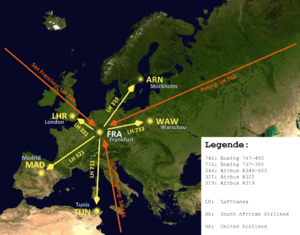Airline hub

Airline hubs are airports that an airline uses as a transfer point to get passengers to their intended destination. It is part of a hub and spoke model, as opposed to the Point to Point model, where travelers moving between airports not served by direct flights change planes en route to their destinations.
Many airlines also use focus cities, which have a good catchment area and function much the same as hubs, but on a smaller scale and may also function as feeders to main hubs. Some airlines also use the term secondary hubs for large focus cities.[1] Some airlines may use only a single hub, while other airlines use multiple hubs. Hubs are used for both passenger flights as well as cargo flights.
A hub in the middle of a route is more effective than at either end as connecting traffic more easily fills the plane - passengers prefer a one-stop (two-leg) route over a two-stop (three-leg) route.[2] The FAA uses the term airline hub based on number of commercial passengers in the FAA airport categories, re-evaluated every year. Airlines often have their headquarters in a major hub.
Competition
A dominant airline will take competitive measures to defend its preferred position at a hub airport.[3] This can stifle competition, for example Pro Air's battle with Northwest when it briefly flew out of Detroit City Airport : Northwest was able to out compete the short-lived discount carrier by matching its fares and offering more frequent flights.[4]
New entrants, such as Spirit Airlines at Detroit Metropolitan Wayne County Airport and Dallas-Fort Worth International Airport, or AirTran at Hartsfield-Jackson Atlanta International Airport, allege to have been the target of exclusionary practices by the dominant carrier, like in Cincinnati/Northern Kentucky International Airport or all Delta Air Lines hubs.
Airports where a single airline's share of flights is at or above 70 percent can be called fortress hub.[5] For example, in 2010 US Airways occupied 85 (plus 1 shared with Lufthansa) out of 97 total gates and accounted for approximately 90% of passenger traffic at Charlotte Douglas International Airport. The existence of fortress hubs makes possible the use of airline booking ploys such as "hidden city" ticketing.
Large hubs
The following carriers uses hubs among the 30 busiest airports by passenger traffic for 2014:[6]
See also
- Focus city
- List of former airline hubs
- List of hub airports
- Point-to-point transit
- Rolling airline hub
- Transportation hub
References
- ↑ Eric Heymann (August 18, 2006). Hans-Joachim Frank, ed. "The future of the hub strategy in the air transport industry" (PDF). Deutsche Bank Research.
- ↑ Schofield, Adrian (27 August 2012). "Competition Heats Up As Carriers Contest Kangaroo Routes". Aviation Week. Retrieved 22 November 2012.
- ↑ "Entry and Competition in the U.S. Airline Industry, special report 255 appendixes" (PDF). http://www.trb.org/Main/Blurbs/152250.aspx''. Transportation Research Board. April 1998.
- ↑ "Online NewsHour: Air Fares". Pbs.org. 1998-06-15.
- ↑ Dr. Mark N. Cooper (1999-01-22). "Freeing Public Policy from the Deregulation Debate: The Airline Industry Comes of Age" (PDF). Consumer Federation of America. pp. 10–11. Archived (PDF) from the original on 3 February 2007. Retrieved 2007-03-17.
- ↑ "Passenger Traffic for past 12 months ending dec. 2014". Airports Council International. 24 March 2015.